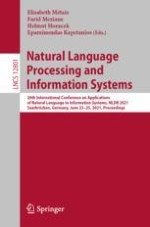2021 | OriginalPaper | Buchkapitel
Virus Causes Flu: Identifying Causality in the Biomedical Domain Using an Ensemble Approach with Target-Specific Semantic Embeddings
verfasst von : Raksha Sharma, Girish Palshikar
Erschienen in: Natural Language Processing and Information Systems
Aktivieren Sie unsere intelligente Suche, um passende Fachinhalte oder Patente zu finden.
Wählen Sie Textabschnitte aus um mit Künstlicher Intelligenz passenden Patente zu finden. powered by
Markieren Sie Textabschnitte, um KI-gestützt weitere passende Inhalte zu finden. powered by
